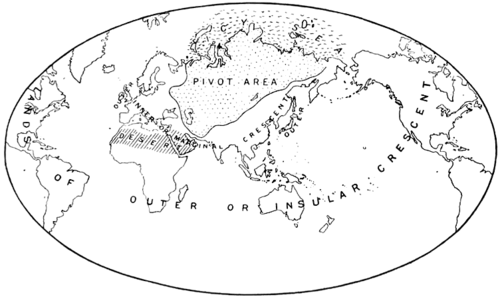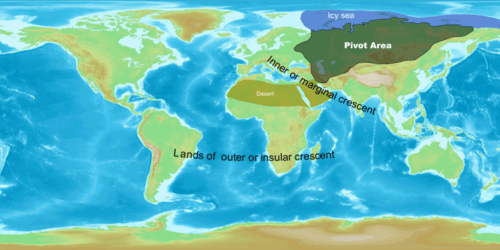The Geographical Pivot of History
The Geographical Pivot of History, sometimes simply as The Pivot of History is a geostrategic theory, also known as Heartland Theory.[1] "The Geographical Pivot of History" was an article submitted by Halford John Mackinder in 1904 to the Royal Geographical Society that advanced his Heartland Theory.[2][3] In this article, Mackinder extended the scope of geopolitical analysis to encompass the entire globe.
The World-Island and the Heartland

According to Mackinder, the Earth's land surface was divisible into:
- The World-Island, comprising the interlinked continents of Europe, Asia, and Africa. This was the largest, most populous, and richest of all possible land combinations.
- The offshore islands, including the British Isles and the islands of Japan.
- The outlying islands, including the continents of North America, South America, and Australia.
The Heartland lay at the centre of the world island, stretching from the Volga to the Yangtze and from the Himalayas to the Arctic. Mackinder's Heartland was the area then ruled by the Russian Empire and after that by the Soviet Union, minus the Kamchatka Peninsula region, which is located in the easternmost part of Russia, near the Aleutian Islands and Kurile islands.
Strategic importance of Eastern Europe
Later, in 1919, Mackinder summarised his theory as:
- "Who rules East Europe commands the Heartland;
- who rules the Heartland commands the World-Island;
- who rules the World-Island commands the world."
- (Mackinder, Democratic Ideals and Reality, p. 150)
Any power which controlled the World-Island would control well over 50% of the world's resources. The Heartland's size and central position made it the key to controlling the World-Island.
The vital question was how to secure control for the Heartland. This question may seem pointless, since in 1904 the Russian Empire had ruled most of the area from the Volga to Eastern Siberia for centuries. But throughout the nineteenth century:
- The West European powers had combined, usually successfully, in the Great Game to prevent Russian expansion.
- The Russian Empire was huge but socially, politically and technologically backward—i.e., inferior in "virility, equipment and organization".
Mackinder held that effective political domination of the Heartland by a single power had been unattainable in the past because:
- The Heartland was protected from sea power by ice to the north and mountains and deserts to the south.
- Previous land invasions from east to west and vice versa were unsuccessful because lack of efficient transportation made it impossible to assure a continual stream of men and supplies.
He outlined the following ways in which the Heartland might become a springboard for global domination in the twentieth century (Sempa, 2000):
- Successful invasion of Russia by a West European nation (most probably Germany). Mackinder believed that the introduction of the railroad had removed the Heartland's invulnerability to land invasion. As Eurasia began to be covered by an extensive network of railroads, there was an excellent chance that a powerful continental nation could extend its political control over the Eastern European gateway to the Eurasian landmass. In Mackinder's words, "Who rules East Europe commands the Heartland."
- A Russo-German alliance. Before 1917 both countries were ruled by autocrats (the Tsar and the Kaiser), and both could have been attracted to an alliance against the democratic powers of Western Europe (the US was isolationist regarding European affairs, until it became a participant of World War I in 1917). Germany would have contributed to such an alliance its formidable army and its large and growing sea power.
- Conquest of Russia by a Sino-Japanese empire (see below).
The combined empire's large East Asian coastline would also provide the potential for it to become a major sea power. Mackinder's "Who rules East Europe commands the Heartland ..." does not cover this scenario, probably because the previous 2 scenarios were seen as the major risks of the nineteenth century and the early 1900s.
One of Mackinder's personal objectives was to warn Britain that its traditional reliance on sea power would become a weakness as improved land transport opened up the Heartland for invasion and / or industrialisation (Sempa, 2000).
Influence of the theory on foreign and military policy

In the Western powers
Mackinder identified the geopolitical nightmare that was to haunt the world's two sea powers during the first half of the twentieth century—Great Britain and, later on, the United States. The nightmare was that if Germany or Russia were allowed to control East Europe then this could lead to the domination of the Eurasian land mass by one of these two powers as a prelude to mastery of the world.
Influence of the theory on other geopolitical models
Evidence of Mackinder's Heartland Theory can be found in the works of geopolitician Dimitri Kitsikis, particularly in his "Intermediate Region" model. There is a significant geographical overlap between the Heartland or "Pivot Area" and the Intermediate Region, with the exception of Germany-Prussia and north-eastern China, which Kitsikis excludes from the Intermediate Region. Mackinder, on the other hand, excludes North Africa, Eastern Europe and the Middle East from the Heartland. The reason for this difference is that Mackinder's model is primarily geo-strategic, while Kitsikis' model is geo-civilizational. However, the roles of both the Intermediate Region and the Heartland are regarded by their respective authors as being pivotal in the shaping of world history.
Criticism
K. S. Gadzhev, in his book Vvedenie v geopolitiku (Introduction to Geopolitics) raises a series of objections to Mackinder's Heartland to start with that the significance physiography is given there for political strategy is a form of geographical determinism.[4]
See also
References
- ↑ Charles Kruszewski, "The Pivot of History", Foreign Affairs, April 1954
- ↑ Mackinder, H.J., "The Geographical Pivot of History", The Geographical Society, Vol. 23, No.4, (April 1904), 421-437
- ↑ Mackinder, H.J., Democratic Ideals and Reality. A Study in the Politics of Reconstruction, National Defense University Press, 1996, pp. 175–193
- ↑ Anita Sengupta, Heartlands of Eurasia: The Geopolitics of Political Space, Lexington Books, 2009
Further reading
- CIA's Analysis of the Soviet Union, 1947-1991 links to a large number of CIA analyses of Soviet economic, technological and military capability (as well as e.g. foreign policy), all in PDF format.
- Christopher, J.F. "Sir Halford Mackinder, Geopolitics, and Policymaking in the 21st Century", Parameters, Summer 2000
- Mackinder, H.J. "The Geographical Pivot of History", in "Democratic Ideals and Reality", Washington, DC: National Defense University Press, 1996, pp. 175–193.
- Odom, W.E. (1998) "The Collapse of the Soviet Military". Yale University Press. ISBN 0-300-08271-1
- Sempa, F.P. (2000) "Mackinder's World" describes the background to Mackinder's thinking, the development of his theory after World War I (with many quotes) and its influence on geo-strategic thinking.
- Venier, Pascal. "The Geographical Pivot of History and Early 20th Century Geopolitical Culture", Geographical Journal, vol. 170, no 4, December 2004, pp. 330–336.
- William R. Keylor, The Twentieth-Century World and Beyond: An International History Since 1900, 2006. ISBN 0-19-516843-7
External links
- The Geographical Pivot of History in The Geographical Journal, April 1904.
- Democratic Ideals and Reality, Washington, DC: National Defence University Press, 1996, pp. 175–194